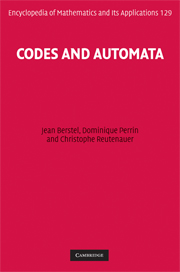Book contents
- Frontmatter
- Contents
- Preface
- 1 Preliminaries
- 2 Codes
- 3 Prefix codes
- 4 Automata
- 5 Deciphering delay
- 6 Bifix codes
- 7 Circular codes
- 8 Factorizations of free monoids
- 9 Unambiguous monoids of relations
- 10 Synchronization
- 11 Groups of codes
- 12 Factorizations of cyclic groups
- 13 Densities
- 14 Polynomials of finite codes
- Solutions of exercises
- Appendix: Research problems
- References
- Index of notation
- Index
4 - Automata
Published online by Cambridge University Press: 05 March 2013
- Frontmatter
- Contents
- Preface
- 1 Preliminaries
- 2 Codes
- 3 Prefix codes
- 4 Automata
- 5 Deciphering delay
- 6 Bifix codes
- 7 Circular codes
- 8 Factorizations of free monoids
- 9 Unambiguous monoids of relations
- 10 Synchronization
- 11 Groups of codes
- 12 Factorizations of cyclic groups
- 13 Densities
- 14 Polynomials of finite codes
- Solutions of exercises
- Appendix: Research problems
- References
- Index of notation
- Index
Summary
In this chapter, we study unambiguous automata. The main idea is to replace computations on words by computations on paths labeled by words. This is a technique which is well known in formal language theory. It will be used here in a special form related to the characteristic property of codes.
Within this frame, the main fact is the equivalence between codes and unambiguous automata. The uniqueness of paths in unambiguous automata corresponds to the uniqueness of factorizations for a code. Unambiguous automata appear to be a generalization of deterministic automata in the same manner as the notion of a code extends the notion of a prefix code.
We present devices for encoding and decoding, using transducers. A special class of transducers, called sequential transducers, is introduced. It will be shown in Chapter 5 to be related to the deciphering delay.
The chapter is organized as follows.
In the first section, we study unambiguous automata in connection with codes. In the next section, the flower automaton is defined. We show that it is a universal automaton in the sense that any unambiguous automaton associated with a code can be obtained by a reduction of the flower automaton of this code. We also show how to decompose the flower automaton of the composition of two codes.
In the last section, we use transducers. We introduce an algorithm to transform a transducer realizing a function into a sequential (possibly infinite) transducer.
Information
- Type
- Chapter
- Information
- Codes and Automata , pp. 177 - 198Publisher: Cambridge University PressPrint publication year: 2009
